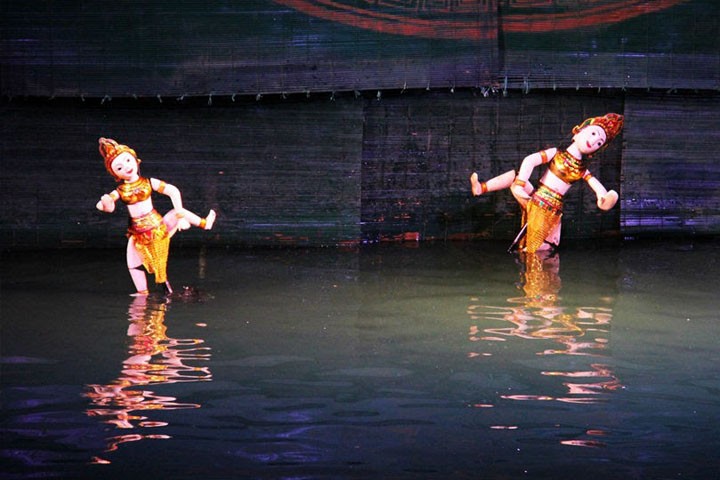
Vietnam water puppet show
What is a water puppet theater?
Water puppetry is a typical cultural product of Vietnam, developed in most villages around Thang Long Citadel and most of the puppet shrines in the provinces of the Northern Delta.
Water Puppetry is considered a distinctive intangible culture of the Vietnamese people, a traditional folk stage art in the Red River delta usually takes place during the holidays, Tet day.
Water puppets have different characteristics from ordinary puppetry; they use stage water (also known as puppet houses or aquariums) erected in the middle of ponds and lakes with balanced architecture symbolizing the roof of the family. In the countryside of Vietnam, behind the backdrops are covered, decorated with the flag, fan, elephant, parasol. The puppets are made of wood, performed by the control of the people behind the fonts. Through the system of poles, wire and is accompanied by drum and flute.
Characters in Water Puppetry
Wooden puppets with their stylized outlines, then peeling, polishing and decorating with different colors to highlight the character of each character. The most typical character is uncle Teu with a round body, smiling wit optimistic.

water puppet characters
Opening screen, uncle Teu appeared cheerful, naughty missions leading the story. The body is in the upper of water surface that represents the character, while the submerged part of the water is where the attached with machine controlled the puppet movement.
Controllers stand in the room to control puppets. They manipulate each pole or pull puppets by wire system arranged outside or under water. Control techniques that make up the action of water puppetry on the stage are key to the art of water puppetry.
Water puppetry must have music which the roles of controlling speed, keeping pace, leading the movement, creating the antique atmosphere with traditional rhythms. Water puppetry mainly uses the traditional folk or folk songs of the North.
History of the water puppet show?
According to legends, historical myth, water puppetry was born from the time of Co Loa, An Duong Vuong, 255 BC. According to history, epitaph, water puppet show in 1121 (Ly dynasty).
In the treasure trove of Vietnamese water, there are 30 traditional items, and hundreds of modern tangled items tell about the folk and daily life of the Vietnamese people. The art of water puppetry is an indigenous cultural characteristic of the Vietnamese nation, developed in most of the villages around Thang Long Citadel and most of the tangle in the provinces of the Northern Delta.
Water puppet show in Vietnam
In India and Southeast Asia, there are only hand puppets and wiring puppetry. Water puppet shows are only in Vietnam and China. According to Prof. J. Pim-Pa-Ne-Au, water puppet theater has disappeared in China and today “only exists in Vietnam.”

Water puppet show in countryside
The Central Puppetry not only performs puppet shows but also encourages the creation of new performances and encourages the study of the history of water puppetry.
At present, there are six professional puppetry troupes in Vietnam: Hanoi, Hai Phong, Ho Chi Minh City, Dak Lak and Quang Tri. There are also dozens of water puppet shows in many localities of the Red River Delta.
In recent years, many Vietnamese water puppetry groups have participated in some international puppetry festivals that have won many awards and have attracted the attention of many countries. With the efforts of Vietnam Water Puppet Association, this art is being protected and developed.
Where can you watch a real water puppet show in Vietnam?
- If you’re visiting big cities in Vietnam
You can buy tickets, then enjoy water puppetry in some big theatres, such as Thang Long Water Puppet Theatre in Hanoi, The Vietnam Puppetry Theatre, Golden Dragon Water Puppet Theatre in Saigon, etc.
- Or you can experience water puppet show in some particular places
It can be performed originally in a Vietnamese village or some museum, such as Yen Duc Village in Quang Ninh Province, The Museum of Vietnamese History in Saigon, etc. It may not be as professional and sparkling as in modern theatres, but it revives original art and culture.
